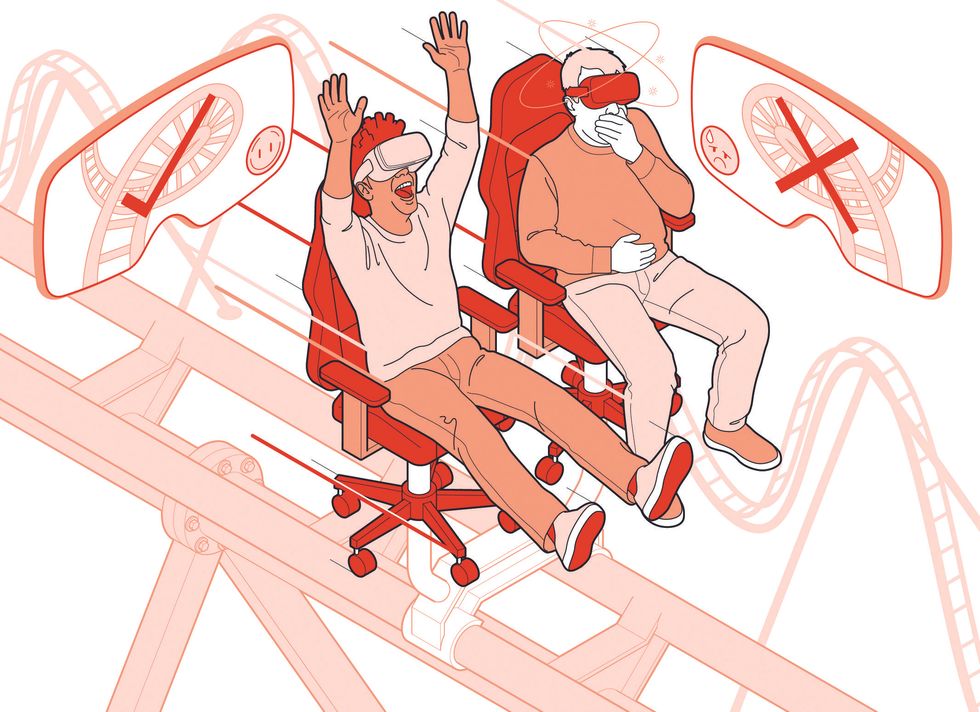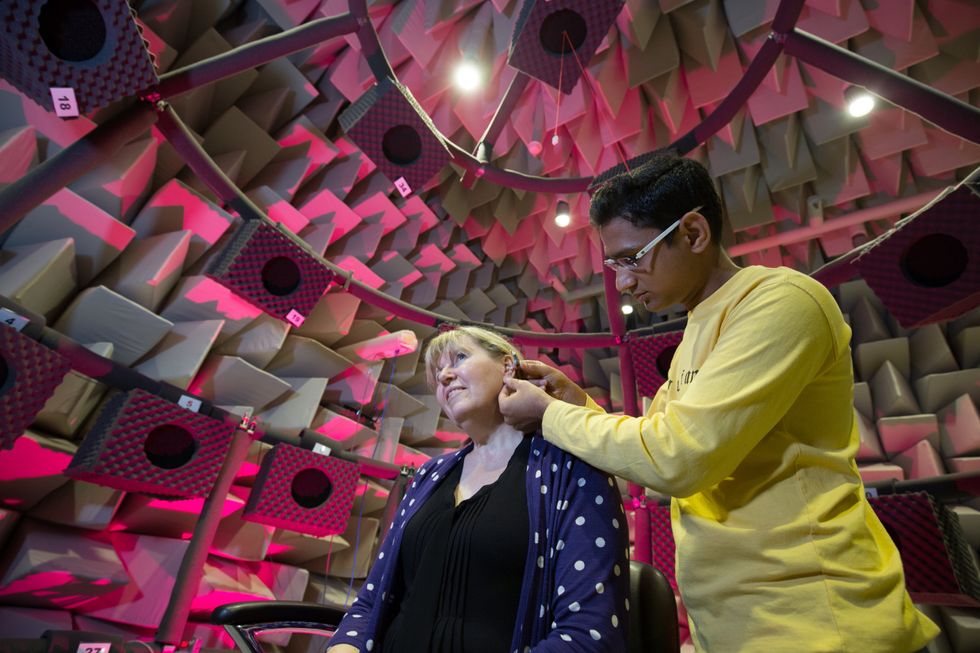Now Reading: Hack Yourself for a Better Time in VR
-
01
Hack Yourself for a Better Time in VR
Hack Yourself for a Better Time in VR

Despite advances in headset hardware and thoughtful software design, virtual reality can still be a nauseating, dizzying, and sweaty experience for some people. From horrific rides on virtual roller coasters to alarming leaps withBeat Saber, you don’t have to talk to many people before someone shares a vomit-inducing experience.
As a psychologist at York St John University, in the United Kingdom, I specialize in how wearers react to VR, and so have been in a prime position to observe the evolving approaches to the problem of cybersickness. Significant progress in hardware—including improved field of view, higher resolution, and reduced latency—haven’t completely solved the issues. Software designs like adding virtual noses in the display, visual attention tasks aimed at redirecting the user’s focus, and enhanced visual realism have all shown promise in the lab but have proven frustratingly difficult to replicate consistently in the real world.
But a new wave of research may take the pressure off engineers and developers and hand it back to the consumer. The research focuses on DIY techniques that allow users to cope better with VR. Here are three promising approaches.
#1: Stand Like a Flamingo
There are different theories about the underlying causes of cybersickness. One idea focuses on postural instability. In real life, our brains interact with our vestibular and proprioceptive systems, which give us a general sense of where our heads or bodies are in the world and create a physiological response that maintains our balance and stops us from falling over.
Maintaining your balance is harder in virtual reality; the world looks like it’s moving, but your body doesn’t feel it. It turns out that your ability to balance is a good predictor of your susceptibility to cybersickness. When researchers studied figure skaters, soccer players, and wushu fighters, for example, the ones most resistant to cybersickness were the figure skaters.
So researchers in South Korea explored whether training people to balance in VR, to give them greater postural stability, would also reduce cybersickness. Participants trained for 3 minutes, twice a day, for five days. In the control group, participants simply stood and watched an experience specifically chosen for its sickness-inducing movement patterns. In the training group, participants watched while they stood on one leg with their arms outstretched—the flamingo pose—for 30 seconds, followed by 30 seconds of standing on two legs, repeated three times.
At the end of the week, both groups reported having fewer symptoms of cybersickness while viewing the training patterns. The participants were then shown new content: a VR experience about space exploration. While the control group reported feeling almost as sick as before the training, those who had been standing like a flamingo reported much less sickness in the new experience, with statistically significant reductions in disorientation. Learning to balance in VR meant they could better handle other VR experiences, not just the one they’d become accustomed to.
 New techniques that show promise in reducing cybersickness include balance exercises [top], leaning into apparent motion in virtual environments [middle], and wearing devices that stimulate the vestibular system [bottom].GyGinfographics.com
New techniques that show promise in reducing cybersickness include balance exercises [top], leaning into apparent motion in virtual environments [middle], and wearing devices that stimulate the vestibular system [bottom].GyGinfographics.com
#2: Lean In
If standing like a flamingo doesn’t sound appealing, then you can try being responsive to the motion in the virtual environment. This technique involves postural alignment, and like the flamingo pose, it builds on the idea that postural instability is an important factor in cybersickness.
If you’ve ever been on a roller coaster, you’ll have an intuition as to how this works. As the roller coaster curves to the right, you oppose the motion by leaning to the left; as it heads to the left, you lean to the right. While that feels like the most natural thing to do, it’s actually unhelpful for motion sickness. You should instead lean “into” the turn—leaning right if you’re going right and left if you’re going left, just as a motorcyclist does when taking a turn at speed.
Leaning into the motion appears to do the same in VR. Researchers in the Netherlands and Greece teamed up to explore this. In their study, they opted for virtual driving simulations on a Meta Quest 3 headset. What mattered was how closely the participants aligned their bodies to the implied motion. Those who maintained closer postural alignment with the virtual motion experienced significantly less cybersickness, with the likelihood of cybersickness worsening with increasing misalignment.
#3: Feel the Vibes
Don’t fancy standing like a flamingo or leaning all over the place? Well, how about vibrating the bones in your skull? This solution requires pressing into service a type of wearable tech that isn’t yet commonly available—a vestibular stimulation device, which sends little vibrations to the inner ear. Researchers are testing these devices to treat seasickness and the symptoms of Parkinson’s disease. Companies like Otolith Labs are now seeking approval to sell their products beyond the research community. Research at the University of Newcastle, in Australia, tested whether the devices could ease VR cybersickness by reducing the mismatch between vestibular cues and visual cues. In VR, your eyes are telling you that your body is moving, but your body is convinced that it’s not, and the mismatch is just too much for the mind to cope with. By vibrating the inner ear with a stimulator, the thinking goes, people may become more tolerant of the mismatch.
Our ability to balance is a good predictor of cybersickness.
To test the idea, the researchers made use of one of the most sickening experiences you can have in VR: a virtual roller coaster. Participants experienced the roller coaster with the vestibular device attached to the mastoid bone behind the right ear, and set to no vibration, a low vibration setting, or the medium setting.
Participants then rode the VR roller coaster for up to 15 minutes, verbally reporting their levels of nausea each minute. The control group had no vibration device, another group had the device on a low setting, and a final group had the device on a medium setting. The control group averaged 478 seconds in the ride before they chose to end the experiment, or staff ended the experiment because of high levels of reported nausea. Those with the low vibration setting lasted considerably longer, at 568 seconds, and those with the medium setting lasted 623 seconds.
Over to the Consumer
Of course, none of these approaches is guaranteed to work. They’re based on pilot projects involving small numbers of participants and awaiting replication. What makes them different from the past is that anyone can try at least the first two at home right now, and there’s not a huge hurdle to eventually trying out the third.
At the end of the day, cybersickness has many possible causes and associations. Perhaps future headsets will reduce the problem. Perhaps well-designed VR experiences will help, too. But the most promising path forward is probably a combination of engineering solutions, design solutions, and user-initiated approaches—such as leaning in, standing like a flamingo, and vibrating those bones. Only time will tell, but maybe one day VR’s sickening curse will be broken.























